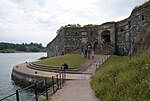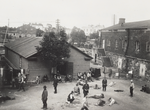Harmaja

Harmaja (Swedish: Gråhara) is an island and a lighthouse outside Helsinki, south of the Suomenlinna sea fortress. The island has been functioning as a landmark since the 16th century. A landmark structure was built on the island in the 18th century and a light house in 1883. The first lighthouse was only 7.3 m high and it soon proved to be too low. In 1900 the height was doubled by creating a rectangular brick building on a granite base. A large foghorn alerted ships in fog and in bad visibility. Harmaja received the world's first directed and undirected radio beacon in 1936. The lighthouse is fully automated today. There is also a pilot station on the island. During the 1952 Summer Olympics this was the center of the Olympic sailing event.
Excerpt from the Wikipedia article Harmaja (License: CC BY-SA 3.0, Authors, Images).Harmaja
Näköalatasanne, Helsinki Suomenlinna (Southern major district)
Geographical coordinates (GPS) Address External links Nearby Places Show on map
Geographical coordinates (GPS)
| Latitude | Longitude |
|---|---|
| N 60.104444444444 ° | E 24.974444444444 ° |
Address
Harmajan majakka
Näköalatasanne
00190 Helsinki, Suomenlinna (Southern major district)
Finland
Open on Google Maps










